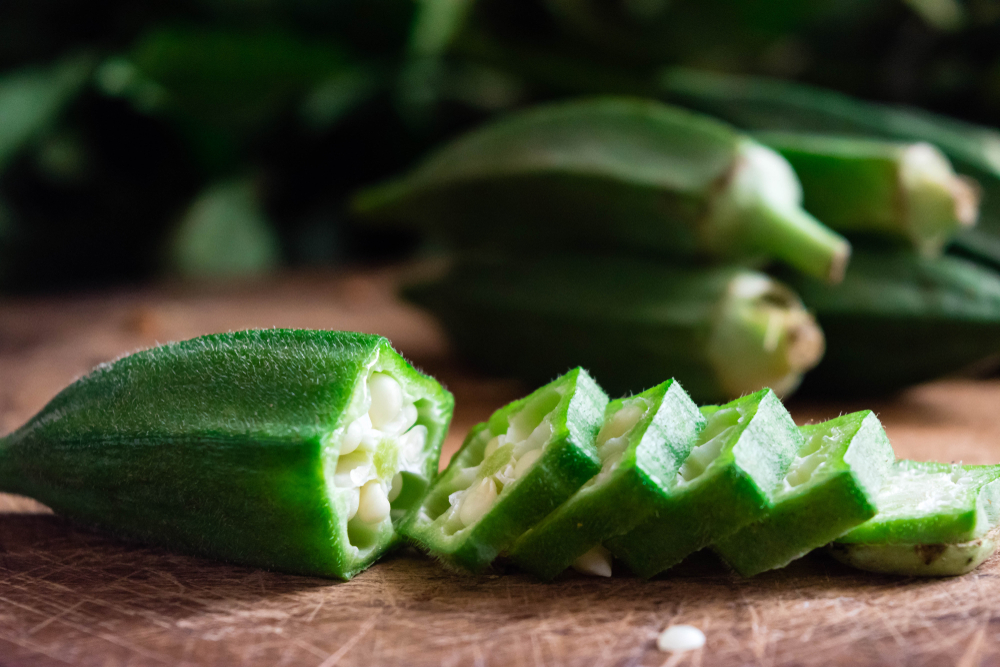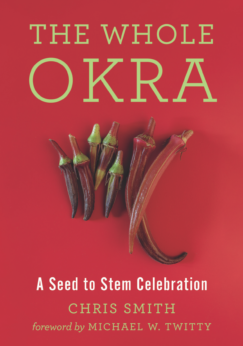For many, okra is synonymous with slimy, fried seedy bits of “I’m not eating that.” But writer Chris Smith sees okra as something to embrace and celebrate through history and recipes. Here’s an excerpt from his just-released book.

Chef Steven Goff, who describes himself as a meat and pickle man, has honed his skills to support a belief that there should be no waste in the kitchen, a belief informed to some extent by growing up poor and living dwelling-free at the beginning of his career. In our early communications he revealed his love for okra. “Definitely one of my top five vegetables,” he said. “Last year I made okra kimchi.”
Goff is the executive chef and partner of Aux Bar in downtown Asheville, where the menu specializes in regional and seasonal ingredients from the Appalachian South. I was lucky enough to spend a morning in the kitchen with Goff and help in the creation of a fresh batch of okra kimchi.
Inspired by his experiences with the Japanese technique for making nukazuke—which uses rice bran (nuka)—Goff rolled the okra pods over a layer of coarse grain salt. This allowed the salt to penetrate the skin and begin the fermentation process without releasing the slime. As the pile of salted okra grew, it visibly sweated as the salt drew moisture out of the pods. We were rolling red okra in salt, which stained both the salt and our hands a beautiful purple. Pods of all shapes and sizes went into the ferment, stems and all, no waste! “Kimchi is a great kitchen trash can,” said Steve. “I collect all sorts of vegetable scraps and ferment them.”
We crushed and shoved the okra into jars without ceremony, adding layers of chi paste that filled the gaps. (See “Okra Kimchi” on page 100 for the recipe.) Like Sandor Katz, and most serious fermenters I know, Goff embraced a casual bit-of-this, bit-of-that style. He threw in some liquid from another ferment to act as starter culture. In part I’m sure Goff’s casual approach to creating kimchi is a product of years of experience, but it’s also an awesome element of fermenting. You get to go a little wild in the kitchen and see what happens! The Okra Kimchi ferment smelled delicious, but I had to wait a few weeks before returning to get the full taste experience.
It was worth it: a tangy, fruity, little-bit-spicy, still-crunchy okra delight. The red pods held their color, and everything remained glazed in the thick kimchi sauce. I enjoy okra in all shapes and forms, but this is one recipe that seared itself into my mouth memory. Every time I think about it, I begin to drool. I swallow the excess saliva, but if I were a dog, it’d be messy.
One last element of the Okra Kimchi is from an idea inspired by Jamie Swofford, a chef-turned-farmer who focuses on flavor. Swofford explained how he dehydrates his ferments. He creates powdered kimchi and uses it as a seasoning that carries the concentrated flavor of the ferment: “Sprinkle a little on fresh cucumber and you get all the crunchy texture of a fresh cucumber and all the flavor of a pickle!” Knowing how well okra dehydrates, and how tasty dried, ground okra pods are, I had to try making the Okra Kimchi spice.
Chef Steven Goff told me to dehydrate the kimchi at 115F (45C) or less; that way the powder can actually be used as a starter culture for other ferments, giving it one more useful application in the kitchen. As I expected, the powder turned out to be incredible. Such a magnificent blend of flavors could never fail. I’m definitely adding dehydrated ferments to my arsenal of kitchen preservation, and it’s fitting that Okra Kimchi was my maiden voyage!
Okra Kimchi by Chef Steven Goff
Servings: 1 Jar
Okra Kimchi was not on my list of must-have recipes when I began writing this book, but stumbling upon chef Steven Goff and his love of okra and anything fermented was a chance encounter I’m truly grateful for. Not only is his Okra Kimchi one of the most delicious and surprising things I have ever tasted, but Goff invited me to his restaurant, Aux Bar, to experience making kimchi. Subsequently, he spent an entire day helping prepare many of the dishes you see beautifully photographed in this book.
- ½ cup (75 g) dried peppers
- (I use arboles)
- 1 cup (250 ml) water
- 1 cup (250 ml) canola oil
- 3 onions, julienned
- 2 leeks, sliced
- 1 cup (140 g) crushed garlic cloves ½ cup (50 g) chopped ginger,
- not peeled
- 1 cup (120 g) bread flour
- 1½ cups (375 ml) cider vinegar ½ cup (110 g) brown sugar
- 1 pound (453 g) whole okra pods

Chi Preparation
Plump the dried peppers by soaking them in the water. Heat the oil in a deep pan on medium-high. Add the onions, leeks, garlic, and ginger once the oil begins smoking. Continue to sauté the vegetables until translucent. Add the flour, vinegar, and sugar and cook for a further 3 to 5 minutes.
Purée with an immersion blender while the mixture is still hot.
Pod Preparation
Roll the okra pods over a layer of coarse salt, sprinkled on a table or countertop. The aim is to puncture the pods with the coarse salt. Roll each pod individually and pile them all in a bowl. Let the okra and salt sit and sweat for 1 to 2 hours.
Slather the okra with the chi paste and then pack the mixture tightly into the jar. Cover the jar with plastic wrap and push out any remaining air. If there are any air gaps at the top of the jar, you can push the plastic down and fill with water to remove them. Cap the jar and leave at room temperature for at least a week. Burp the jar frequently and refrigerate when the okra is sour enough to suit your tastes.
Any remaining chi can be used in other kimchi projects or as a sauce.
From The Whole Okra: A Seed to Stem Celebration by Chris Smith, © 2019 by Chris Smith. Reprinted by arrangement with Chelsea Green Publishing, White River Junction, VT. www.chelseagreen.com
For Diabetics the slime is the best part of Okra. With Okra as part of a meal the mucalige in the Okra coats the meal as it passes through the gut, slowing digestion and thereby preventing blood sugar spikes.
Very nice article. I loved reading it as Okra is also my top favorite vegetable. Although I have never tried or cooked it this way. Its good to learn about the novel cooking trends.
Moreover, I am also interested to write an article for modern farmer and have emailed them twice- yet waiting for response. Can anybody here kindly guide me through?
How to up root my orka plants for next year.
I was just wondering if dehydrated ferments works! Since the flavor is so much more concentrated, would it be too intense to just eat rehydrated as a side dish? I was thinking of dehydrating a bunch of kimchi and kraut.